Review of the U.S. Policies, Codes, and Standards of Zero-Carbon Buildings
Abstract
1. Introduction
2. Legislations and Policies
2.1. The Definition and Boundaries of Zero-Carbon Buildings
2.2. Federal Level
2.3. Local Level
2.4. Policy Highlights
3. Relevant Codes and Standards
3.1. Federal Level
3.2. Local Level
3.3. Professional Societies
- (1)
- Architecture 2030 ZERO Code
- (2)
- ILFI Zero Carbon Standard
- (3)
- USGBC LEED Zero
3.4. Highlights for Codes and Standards
4. Discussion
4.1. Successful Experience
4.1.1. System Work: Multilevel Governance
4.1.2. Code Enforcement
4.1.3. Code Compliance
4.1.4. Information Transparency
4.1.5. Financial Support and Market Forces
4.2. Lessons Learned
4.2.1. Metric Choice and Embodied Carbon Involvement in ZCB Codes
4.2.2. Embodied Carbon Data Tracking and Benchmarking (Tools, Measurement, and Guidance)
4.2.3. Individual Involvement and Education
5. Conclusions and Recommendations
Author Contributions
Funding
Data Availability Statement
Conflicts of Interest
References
- Pörtner, H.O.; Roberts, D.C.; Adams, H.; Adler, C.; Aldunce, P.; Ali, E.; Begum, R.A.; Betts, R.; Kerr, R.B.; Biesbroek, R.; et al. Climate Change 2022: Impacts, Adaptation and Vulnerability; IPCC: Geneva, Swizterland, 2022. [Google Scholar]
- Falkner, R. The Paris Agreement and the new logic of international climate politics. Int. Aff. 2016, 92, 1107–1125. [Google Scholar] [CrossRef]
- Jacobs, M. Reflections on COP26: International diplomacy, global justice and the greening of capitalism. Polit. Q. 2022, 93, 270–277. [Google Scholar] [CrossRef]
- Sun, L.L.; Cui, H.J.; Ge, Q.S. Will China achieve its 2060 carbon neutral commitment from the provincial perspective? Adv. Clim. Chang. Res. 2022, 13, 169–178. [Google Scholar] [CrossRef]
- Pianta, M.; Lucchese, M. Rethinking the European Green Deal: An industrial policy for a just transition in Europe. Rev. Radic. 2020, 52, 633–641. [Google Scholar] [CrossRef]
- White House. FACT SHEET: President Biden Sets 2030 Greenhouse Gas Pollution Reduction Target Aimed at Creating Good-Paying Union Jobs and Securing U.S. Leadership on Clean Energy Technologies; The White House: Washington, DC, USA, 2021.
- White House. ICYMI: President Biden Signs Executive Order Catalyzing America’s Clean Energy Economy through Federal Sustainability; The White House: Washington, DC, USA, 2021.
- Bem, P.; Charles, H.; Warren, L.; Wafa, M.E.; Samantha, D. Guide to 100% Clean Energy States. Clean Energy States Alliance. 2022. Available online: https://www.cesa.org/projects/100-clean-energy-collaborative/guide/ (accessed on 20 September 2022).
- Zeng, L.; Li, R.Y.M.; Mao, Y.; Chen, H.; Zeng, H. A comparative study on LinkedIn and Sina Weibo users’ perceptions of the carbon-neutral city. Front. Environ. Sci. 2022, 10, 1220. [Google Scholar] [CrossRef]
- Qiu, B. Urban carbon neutralization and green building. Urban Study. 2021, 28, 1–7. [Google Scholar]
- Cortese, A. The Embodied Carbon Conundrum: Solving for All Emission Sources from the Built Environment. Available online: https://newbuildings.org/embodied-carbon-conundrum-solving-for-all-emission-sources-from-the-built-environment/ (accessed on 20 September 2022).
- U.S. Energy Information Administration (EIA). U.S. Energy-Related Carbon Dioxide Emissions, 2020; U.S. Energy Information Administration: Washington, DC, USA, 2021.
- Bonoli, A.; Zanni, S.; Serrano-Bernardo, F. Sustainability in building and construction within the framework of circular cities and European new green deal. The contribution of concrete recycling. Sustainability. 2021, 13, 2139. [Google Scholar] [CrossRef]
- Ohene, E.; Chan, A.P.C.; Darko, A. Prioritizing barriers and developing mitigation strategies toward net-zero carbon building sector. Build. Environ. 2022, 223, 109437. [Google Scholar] [CrossRef]
- Becqué, R.; Weyl, D.; Stewart, E.; Mackres, E.; Shen, X.; Jin, L. Accelerating Building Decarbonization: Eight Attainable Policy Pathways to Net Zero Carbon Buildings for All; World Resources Institute: Washington, DC, USA, 2019. [Google Scholar]
- Architecture 2030. A Brief Introduction to the Development of Zero Energy and Zero Carbon Buildings in the United States. 2018. Available online: https://china.architecture2030.org/the-development-of-znc-and-zne-in-the-us/ (accessed on 20 September 2022).
- Marszal, A.J.; Heiselberg, P.; Bourrelle, J.S.; Musall, E.; Voss, K.; Sartori, I.; Napolitano, A. Zero Energy Building—A review of definitions and calculation methodologies. Energy Build. 2011, 43, 971–979. [Google Scholar] [CrossRef]
- Riedy, C.; Lederwasch, A.J.; Ison, N. Defining Zero Emission Buildings—Review and Recommendations: Final Report; University of Technology Sydney: Sydney, Australia, 2011. [Google Scholar]
- Pan, W. System boundaries of zero carbon buildings. Renew. Sustain. Energy Rev. 2014, 37, 424–434. [Google Scholar] [CrossRef]
- Sartori, I.; Napolitano, A.; Voss, K. Net zero energy buildings: A consistent definition framework. Energy Build. 2012, 48, 220–232. [Google Scholar] [CrossRef]
- Zhang, J.; Zhou, N.; Hinge, A.; Feng, W.; Zhang, S. Governance strategies to achieve zero-energy buildings in China. Build. Res. Inf. 2016, 44, 604–618. [Google Scholar] [CrossRef]
- Hernandez, P.; Kenny, P. From net energy to zero energy buildings: Defining life cycle zero energy buildings (LC-ZEB). Energy Build. 2010, 42, 815–821. [Google Scholar] [CrossRef]
- Zuo, J.; Read, B.; Pullen, S.; Shi, Q. Carbon-neutral commercial building development. J. Manag. Eng. 2013, 29, 95–102. [Google Scholar] [CrossRef]
- Yang, F. Whole Building Life Cycle Assessment: Reference Building Structure and Strategies; American Society of Civil Engineers: Reston, VA, USA, 2018. [Google Scholar]
- Pless, S.; Torcellini, P. Net-Zero Energy Buildings: A Classification System Based on Renewable Energy Supply Options; National Renewable Energy Laboratory: Golden, CO, USA, 2010. [Google Scholar]
- Esram, N.W.; Hu, M. Knowledge Infrastructure: The Critical Path to Advance Embodied Carbon Building Codes; White Paper; American Council for an Energy-Efficient Economy: Washington, DC, USA, 2021. [Google Scholar]
- White House. Executive Order 12873 of October 20, 1993 Federal Acquisition, Recycling, and Waste Prevention; White House: Washington, DC, USA, 1993; Volume 58.
- Federal Facilities Environmental Stewardship & Compliance Assistance Center. Executive Order 13423 (Archive)—Revoked by EO 13693 on March 19, 2015, Sec. 16(a); FedCenter: Urbana, IL, USA, 2015. [Google Scholar]
- Torcellini, P.; Pless, S.; Deru, M. Zero Energy Buildings: A Critical Look at the Definition. In Proceedings of the ACEEE Summer Study, Pacific Grove, CA, USA, 14−18 August 2006; National Renewable Energy Laboratory: Golden, CO, USA, 2006. [Google Scholar]
- Obama, B. Executive Order 13514: Federal Leadership in Environmental, Energy, and Economic Performance, 2012th ed.; United States Government Printing Office: Washington, DC, USA, 2009.
- White House. Executive Order 13693 of March 19, 2015 Planning for Federal Sustainability in the Next Decade; White House: Washington, DC, USA, 2015; Volume 80, pp. 15871–15884. [Google Scholar]
- Peterson, K.; Torcellini, P.; Grant, R.; Taylor, C.; Punjabi, S.; Diamond, R.; Colker, R.; Moy, G.; Kennett, E. A Common Definition for Zero Energy Buildings; U.S. Department of Energy and the National Institute of Building Sciences: Washington, DC, USA, 2015. [Google Scholar]
- Corrado, C.R.; DeLong, S.M.; Holt, E.G.; Hua, E.Y.; Tolk, A. Combining Green Metrics and Digital Twins for Sustainability Planning and Governance of Smart Buildings and Cities. Sustainability 2022, 14, 12988. [Google Scholar] [CrossRef]
- White House. Federal Sustainability Plan: Catalyzing America’s Clean Energy Industries and Jobs; Office of the Federal Chief Sustainability Office: Washington, DC, USA, 2021.
- Federal Chief Sustainability Officer (CSO). Net-Zero Emissions Buildings by 2045, Including a 50% Reduction by 2032. Available online: https://www.sustainability.gov/federalsustainabilityplan/buildings.html (accessed on 20 September 2022).
- United States Environmental Protection Agency (EPA). National Recycling Strategy. 2022. Available online: https://www.epa.gov/recyclingstrategy/national-recycling-strategy (accessed on 20 September 2022).
- Dalke, R.; Demro, D.; Khalid, Y.; Wu, H.; Urgun-Demirtas, M. Current status of anaerobic digestion of food waste in the United States. Renew. Sustain. Energy Rev. 2021, 151, 111554. [Google Scholar] [CrossRef]
- Cox, R. It All Adds up to Zero California’s Zero Net Energy Future (and What We’re Doing about It). 10007451-HOU-R-02-D. 2017. Available online: https://www.cpuc.ca.gov/-/media/cpuc-website/files/legacyfiles/c/6442455019-cpuc-staff-presentation-bayren-10-24-2017.pdf (accessed on 20 September 2022).
- California Public Utilities Commission. Residential Zero Net Energy Building Integration Cost Analysis; 10007451-HOU-R-02-D; California Public Utilities Commission: San Francisco, CA, USA, 2017.
- Pan, W.; Pan, M. A ‘demand-supply-regulation-institution’ stakeholder partnership model of delivering zero carbon buildings. Sustain. Cities Soc. 2020, 62, 102359. [Google Scholar] [CrossRef]
- Iyer-Raniga, U. Zero energy in the built environment: A holistic understanding. Appl. Sci. 2019, 9, 3375. [Google Scholar] [CrossRef]
- Seto, K.C.; Churkina, G.; Hsu, A.; Keller, M.; Newman, P.W.; Qin, B.; Ramaswami, A. From low-to net-zero carbon cities: The next global agenda. Annu. Rev. Environ. Resour. 2021, 46, 377–415. [Google Scholar] [CrossRef]
- Tarroja, B.; Chiang, F.; AghaKouchak, A.; Samuelsen, S.; Raghavan, S.V.; Wei, M.; Sun, K.; Hong, T. Translating climate change and heating system electrification impacts on building energy use to future greenhouse gas emissions and electric grid capacity requirements in California. Appl. Energy 2018, 225, 522–534. [Google Scholar] [CrossRef]
- Leung, J.; Decarbonizing U.S. buildings; Center for Climate and Energy Solutions C2ES. 2018. Available online: https://www.c2es.org/document/decarbonizing-u-s-buildings/ (accessed on 20 September 2022).
- California Energy Commission (CEC). 2022 Building Energy Efficiency Standards Summary; California Energy Commission: Sacramento, CA, USA, 2022.
- Wei, M.; Lee, S.H.; Hong, T.; Conlon, B.; McKenzie, L.; Hendron, B.; German, A. Approaches to cost-effective near-net zero energy new homes with time-of-use value of energy and battery storage. Adv. Appl. Energy 2021, 2, 100018. [Google Scholar] [CrossRef]
- Simonelli, J. Home rule and natural gas development in New York: Civil fracking rights. J. Political Ecol. 2014, 21, 258–278. [Google Scholar] [CrossRef][Green Version]
- New York City Council. Legislation Details (with Text) Use of Substances with Certain Emissions Profiles; New York City Council: New York, NY, USA, 2021.
- Snyder, M. Decarbonize Housing: Centering Equity While Phasing Out Natural Gas. Chic. Pol. Rev. 2022. Available online: https://chicagopolicyreview.org/2022/04/27/decarbonize-housing-centering-equity-while-phasing-out-natural-gas/ (accessed on 20 September 2022).
- Horn, P. Leaders in Small Solar. 2021. Available online: https://insideclimatenews.org/news/16122021/inside-clean-energy-california-rooftop-solar-policy/ (accessed on 20 September 2022).
- Hasanbeigi, A.; Shi, D.; Khuta, H. Federal Buy Clean Policy for Construction Materials in the United States; American Council for an Energy Efficient Economy: Washington, DC, USA, 2021. [Google Scholar]
- California Department of General Services. Buy Clean California Act; Department of General Services Procurement Division: Sacramento, CA, USA, 2021. [Google Scholar]
- California Legislative Information. Public Contract Code—Division 2. General Provisions [1100–22,355] Part 1. Administrative Provisions [1100–9204] Chapter 3. Formation [3000–3505] Article 5. Buy Clean California Act [3500–3505]; California Legislative Information: Sacramento, CA, USA, 2017. [Google Scholar]
- Colorado General Assembly. HB21-1303 Global Warming Potential for Public Project Materials (the Formal Name of the Buy Clean Colorado Legislation); Colorado General Assembly: Denver, CO, USA, 2021. [Google Scholar]
- International Code Council. 2021 International Energy Conservation Code (IECC); International Code Council: Washington, DC, USA, 2021. [Google Scholar]
- ANSI/ASHRAE/IES Standard 90.1-2019; Energy Standard for Buildings Except Low-Rise Residential Buildings. American Society of Heating, Refrigerating and Air-Conditioning Engineers (ASHRAE): Altanta, GA, USA, 2019.
- ASHRAE/ICC/USGBC/IES 189.1-2020; Standard for Design of High-Performance Green Buildings. American Society of Heating, Refrigerating and Air-Conditioning Engineers (ASHRAE): Altanta, GA, USA, 2020.
- ANSI/ASHRAE/IES Standard 90.1-2019; Energy Savings Analysis. Department of Energy (DOE): Washington, DC, USA, 2021. [CrossRef]
- Geller, H.; Harrington, P.; Rosenfeld, A.H.; Tanishima, S.; Unander, F. Polices for increasing energy efficiency: Thirty years of experience in OECD countries. Energy Policy 2006, 34, 556–573. [Google Scholar] [CrossRef]
- New Building Institute. Local Governments Vote Resoundingly for Improved National Energy Codes. 2019. Available online: https://newbuildings.org/local-governments-vote-resoundingly-for-improved-national-energy-codes/ (accessed on 20 September 2022).
- Salcido, V.R.; Chen, Y.; Xie, Y.; Taylor, Z.T. Energy Savings Analysis: 2021 IECC for Residential Buildings; Pacific Northwest National Laboratory: Alexandria, Egypt, 2021. [Google Scholar]
- Levinson, A. Energy intensity: Deindustrialization, composition, prices, and policies in US states. Resour. Energy Econ. 2021, 65, 101243. [Google Scholar] [CrossRef]
- ASHRAE; AIA; IES; USGBC; DOE. Advanced Energy Design Guide Series: 30% Energy Savings; ASHRAE: Peachtree Corners, GA, USA, 2009. [Google Scholar]
- ASHRAE; AIA; IES; USGBC; DOE. Advanced Energy Design Guide Series: 50% Energy Savings; ASHRAE: Peachtree Corners, GA, USA, 2015. [Google Scholar]
- ASHRAE; AIA; IES; USGBC; DOE. The Advanced Energy Design Guide: Achieving Zero Energy Series; ASHRAE: Peachtree Corners, GA, USA, 2018. [Google Scholar]
- Chen, K. A cooperative federalism model for building energy codes. Columbia Law Rev. 2021, 121, 2119–2156. [Google Scholar]
- DOE. Building Energy Codes Program—State Portal; Office of Energy Efficiency & Renewable Energy: Washington, DC, USA, 2022.
- Gibbs, M.E.; Hsain, Z.; Reagan, E.K.; Wolfman, S.; Zaccarin, A.M. Overcoming State-Level Preemption to Electrify New Buildings: A Philadelphia Case Study. J. Glob. Policy Gov. 2022, 21. [Google Scholar] [CrossRef]
- Appendix AA-Stretch Energy Code: An Act Relative to Green Community. 2008. Available online: https://www.google.com/search?client=firefox-b-d&q=Appendix+AA-Stretch+Energy+Code%3A+An+Act+Relative+to+Green+Community (accessed on 20 September 2022).
- City of Santa Monica. Santa Monica Residential Zero Net Energy Guide for New Construction; New Buildings Institute: Santa-Monica, CA, USA, 2020. [Google Scholar]
- City of Massachusetts. Building Energy Code: Summary of State Building Energy Codes Including the Stretch Code. 2008. Available online: https://www.mass.gov/info-details/building-energy-code (accessed on 20 September 2022).
- Chen, Y.; Liu, B.; Zhang, J.; Rosenberg, M.I.; Edelson, J.; Lyles, M. Final Energy Savings Analysis of the Proposed NYStretch-Energy Code 2018; Pacific Northwest National Laboratory: Richland, WA, USA, 2019. [Google Scholar]
- New York State Energy Research and Development Authority. NYStretch Energy Code: 2020 Outreach, Training and Resources. New York. 2022. Available online: https://www.nyserda.ny.gov/All-Programs/Energy-Code-Training/NYStretch-Energy-Code-2020 (accessed on 20 September 2022).
- City of Santa Monica. Climate-Friendly Buildings: A New Construction Guide to Support Santa Monica’s Energy Reach Code; New Buildings Institute: Santa-Monica, CA, USA, 2019. [Google Scholar]
- Department of Energy. Status of State Energy Code Adoption. 2021. Available online: https://www.energycodes.gov/status (accessed on 20 September 2022).
- California Energy Commission (CEC). Past Building Energy Efficiency Standards. 2022. Available online: https://www.energy.ca.gov/programs-and-topics/programs/building-energy-efficiency-standards/past-building-energy-efficiency (accessed on 20 September 2022).
- Novan, K.; Smith, A.; Zhou, T. Residential Building Codes Do Save Energy: Evidence from Hourly Smart-Meter Data. Rev. Econ. Stat. 2020, 104, 483–500. [Google Scholar] [CrossRef]
- Brown, E.G.; Weisenmiller, R.B.; Bohan, D.; Douglas, K.; Hochschild, D.; McAllister, J.A.; Scott, J.A. 2019 Building Energy Efficiency Standards Frequently Asked Questions; California Energy Commission: Sacramento, CA, USA, 2020.
- City of Lodi. 2019 California Energy Code Changes. 2019. Available online: https://www.lodi.gov/DocumentCenter/View/2985/2019-California-Energy-Changes-PDF (accessed on 20 September 2022).
- California Building Standards Council. CALGreen (The California Green Building Standards Code—Part 11, Title 24, California Code of Regulations); California Building Standards Council: Sacramento, CA, USA, 2020. [Google Scholar]
- Institute for Market Transformation (IMT). Comparison of U.S. Building Performance Standard; Institute for Market Transformation: Washington, DC, USA, 2021. [Google Scholar]
- Wang, N.; Phelan, P.E.; Harris, C.; Langevin, J.; Nelson, B.; Sawyer, K. Past visions, current trends, and future context: A review of building energy, carbon, and sustainability. Renew. Sustain. Energy Rev. 2018, 82, 976–993. [Google Scholar] [CrossRef]
- International Living Future Institute. Zero Carbon Standard 1.0: A Program to Catalyze Progress towards a Carbon-Positive Built Environment. 2021. Available online: https://www2.living-future.org/zero-carbon-standard (accessed on 20 September 2022).
- United State Green Building Council (USGBC). LEED Zero Program Guide; United State Green Building Council: Washington, DC, USA, 2020. [Google Scholar]
- Architecture 2030. ZERO Code2.0: A National and International Building Energy Standard for New Commercial, Institutional, and Mid- to High-Rise Residential Buildings; Architecture 2030: Santa Fe, NM, USA, 2020. [Google Scholar]
- Eley, C.; Mazria, E.; Martinez, V. Zero Code Technical Support Document 2.0: Off-Site Procurement of Renewable Energy; Architecture 2030: Santa Fe, NM, USA, 2020. [Google Scholar]
- Zhang, S.; Xu, W.; Wang, K.; Feng, W.; Athienitis, A.; Hua, G.; Okumiya, M.; Yoon, G.; Woo Cho, D.; Iyer-Raniga, U.; et al. Scenarios of energy reduction potential of zero energy building promotion in the Asia-Pacific region to year 2050. Energy 2020, 213, 118792. [Google Scholar] [CrossRef]
- Architecture 2030. The 2022 Zero Code for California; Architecture 2030: Santa Fe, NM, USA, 2020. [Google Scholar]
- International Living Future Institute. Zero Carbon Certification; International Living Future Institute: Seattle, WA, USA, 2022. [Google Scholar]
- Hunkeler, D. Life Cycle Assessment (LCA): A Guide to Best Practice. Int. J. LCA 2016, 21, 1063–1066. [Google Scholar] [CrossRef]
- One Click LCA. Life Cycle Assessment for Buildings; One Click LCA: Helsinki, Finland, 2021. [Google Scholar]
- RICS. Methodology to Calculate Embodied Carbon of Materials; Royal Institution of Chartered Surveyors: London, UK, 2012. [Google Scholar]
- Green-e. The Green-e Climate Standard Version 2.1; Center for Resource Solutions: San Francisco, CA, USA, 2013. [Google Scholar]
- Zhang, Y.; Wang, J.; Hu, F.; Wang, Y. Comparison of evaluation standards for green building in China, Britain, United States. Renew. Sustain. Energy Rev. 2017, 68, 262–271. [Google Scholar] [CrossRef]
- United States Environmental Protection Agency (EPA). Emission Factors for Greenhouse Gas Inventories; United States Environmental Protection Agency (EPA): Washington, DC, USA, 2018.
- Betsill, M.; Bulkeley, H. Cities and Climate Change; Routledge: London, UK, 2003. [Google Scholar]
- Jänicke, M. The multi-level system of global climate governance—The model and its current state. Environ. Policy Gov. 2017, 27, 108–121. [Google Scholar] [CrossRef]
- Bomberg, E. Mind the (mobilization) gap: Comparing climate activism in the United States and European Union. Rev. Policy Res. 2012, 29, 408–430. [Google Scholar] [CrossRef]
- Moser, S. In the Long Shadows of Inaction: The Quiet Building of a Climate Protection Movement in the United States. Glob. Environ. Polit. 2007, 7, 124–144. [Google Scholar] [CrossRef]
- Rabe, B. States on Steroids: The Intergovernmental Odyssey of American Climate Change Policy. Rev. Policy Res. 2008, 25, 105–128. [Google Scholar] [CrossRef]
- Derthick, M. Compensatory federalism. In Greenhouse Governance: Addressing Climate Change in America; Rabe, B.G., Ed.; Brookings Institution Press: Washington, DC, USA, 2010; pp. 58–72. [Google Scholar]
- Liu, B.; Wang, J.; Li, R.Y.M.; Peng, L.; Mi, L. Achieving Carbon Neutrality—The Role of Heterogeneous Environmental Regulations on Urban Green Innovation. Front. Ecol. Evol. 2022, 10, 471. [Google Scholar] [CrossRef]
- Liu, Z.; Zhou, Q.; Tian, Z.; He, B.; Jin, G. A comprehensive analysis on definitions, development, and policies of nearly zero energy buildings in China. Renew. Sust. Energ. Rev. 2019, 114, 109314. [Google Scholar] [CrossRef]
- Boyano, A.; Hernandez, P.; Wolf, O. Energy demands and potential savings in European office buildings: Case studies based on EnergyPlus simulations. Energy Build. 2013, 65, 19–28. [Google Scholar] [CrossRef]
- Feng, W.; Zhang, Q.; Ji, H.; Wang, R.; Zhou, N.; Ye, Q.; Hao, B.; Li, Y.; Luo, D.; Lau, S.S.Y. A review of net zero energy buildings in hot and humid climates: Experience learned from 34 case study buildings. Renew. Sust. Energy Rev. 2019, 114, 109303. [Google Scholar] [CrossRef]
- Wang, R.; Feng, W.; Wang, L.; Lu, S. A comprehensive evaluation of zero energy buildings in cold regions: Actual performance and key technologies of cases from China, the US, and the European Union. Energy 2021, 215, 118992. [Google Scholar] [CrossRef]
- U.S. Department of Energy. Determinations. 2021. Available online: https://www.energycodes.gov/determinations (accessed on 20 September 2022).
- Zhou, N.; Khanna, N.; Feng, W. Policy Roadmap to 50% Energy Reduction in Chinese Buildings by 2050. In Proceedings of the 2016 ACEEE Summer Study on Energy Efficiency in Buildings, Pacific Groove, CA, USA, 21–26 August 2016; pp. 1–9. [Google Scholar]
- Hu, S.; Zhang, Y.; Yang, Z.; Yan, D.; Jiang, Y. Challenges and opportunities for carbon neutrality in China’s building sector—Modelling and data. Build. Simul. 2022, 15, 1899–1921. [Google Scholar] [CrossRef]
- Sun, K.; Hong, T.; Kim, J.; Hooper, B. Application and evaluation of a pattern-based building energy model calibration method using public building datasets. Build. Simul. 2022, 15, 1385–1400. [Google Scholar] [CrossRef]
- Zhou, Z.; Wang, C.; Sun, X.; Gao, F.; Feng, W.; Zillante, G. Heating energy saving potential from building envelope design and operation optimization in residential buildings: A case study in northern China. J. Clean. Prod. 2018, 174, 413–423. [Google Scholar] [CrossRef]
- Yan, D.; Zhou, X.; An, J.; Kang, X.; Bu, F.; Chen, Y.; Pan, Y.; Gao, Y.; Zhang, Q.; Zhou, H.; et al. DeST 3.0: A new-generation building performance simulation platform. Build. Simul. 2022, 15, 1849–1868. [Google Scholar] [CrossRef]
- Song, M.; Liu, X.; Hu, S.; Wen, Q.; Yan, D. Building a greener future—Progress of the green building technology in the “13th Five-Year Plan” of China. Build. Simul. 2022, 15, 1705–1707. [Google Scholar] [CrossRef]
- Rabe, B.; Borick, C. Carbon taxation and policy labeling: Experience from American states and Canadian provinces. Rev. Policy Res. 2012, 29, 358–382. [Google Scholar] [CrossRef]
- Williams, J.H.; Jones, R.A.; Haley, B.; Kwok, G.; Hargreaves, J.; Farbes, J.; Torn, M.S. Carbon-Neutral Pathways for the United States. AGU Adv. 2021, 2, e2020AV000284. [Google Scholar] [CrossRef]
- Hu, M. A Building Life-Cycle Embodied Performance Index—The Relationship between Embodied Energy, Embodied Carbon and Environmental Impact. Energies 2020, 13, 1905. [Google Scholar] [CrossRef]
- Simonen, K.; Huang, M.; Rodriguez, B.; Todaro, L. Life Cycle Assessment of Buildings: A Practice Guide; Carbon Leadership Forum: Seattle, WA, USA, 2019. [Google Scholar]
- Xia, J.; Hong, T.; Shen, Q.; Feng, W.; Yang, L.; Im, P.; Lu, A.; Bhandari, M. Comparison of building energy use data between the United States and China. Energy Build. 2014, 78, 165–175. [Google Scholar] [CrossRef]
- Lavagna, M.; Baldassarri, C.; Campioli, A.; Giorgi, S.; Dalla Valle, A.; Castellani, V.; Sala, S. Benchmarks for environmental impact of housing in Europe: Definition of archetypes and LCA of the residential building stock. Build. Environ. 2018, 145, 260–275. [Google Scholar] [CrossRef]
- Sabatier, P. An advocacy coalition framework of policy change and the role of policy-oriented learning therein. Policy Sci. 1988, 21, 129–168. [Google Scholar] [CrossRef]
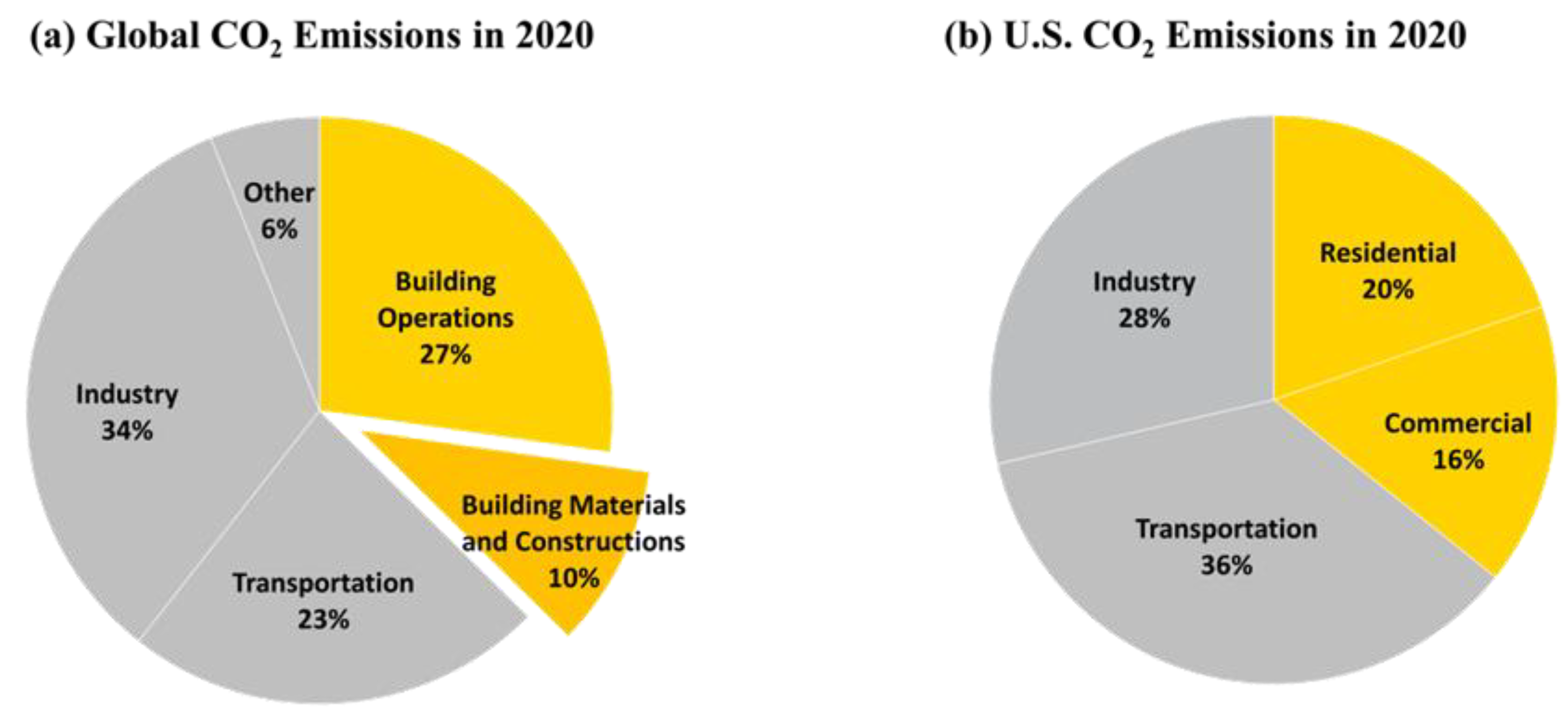
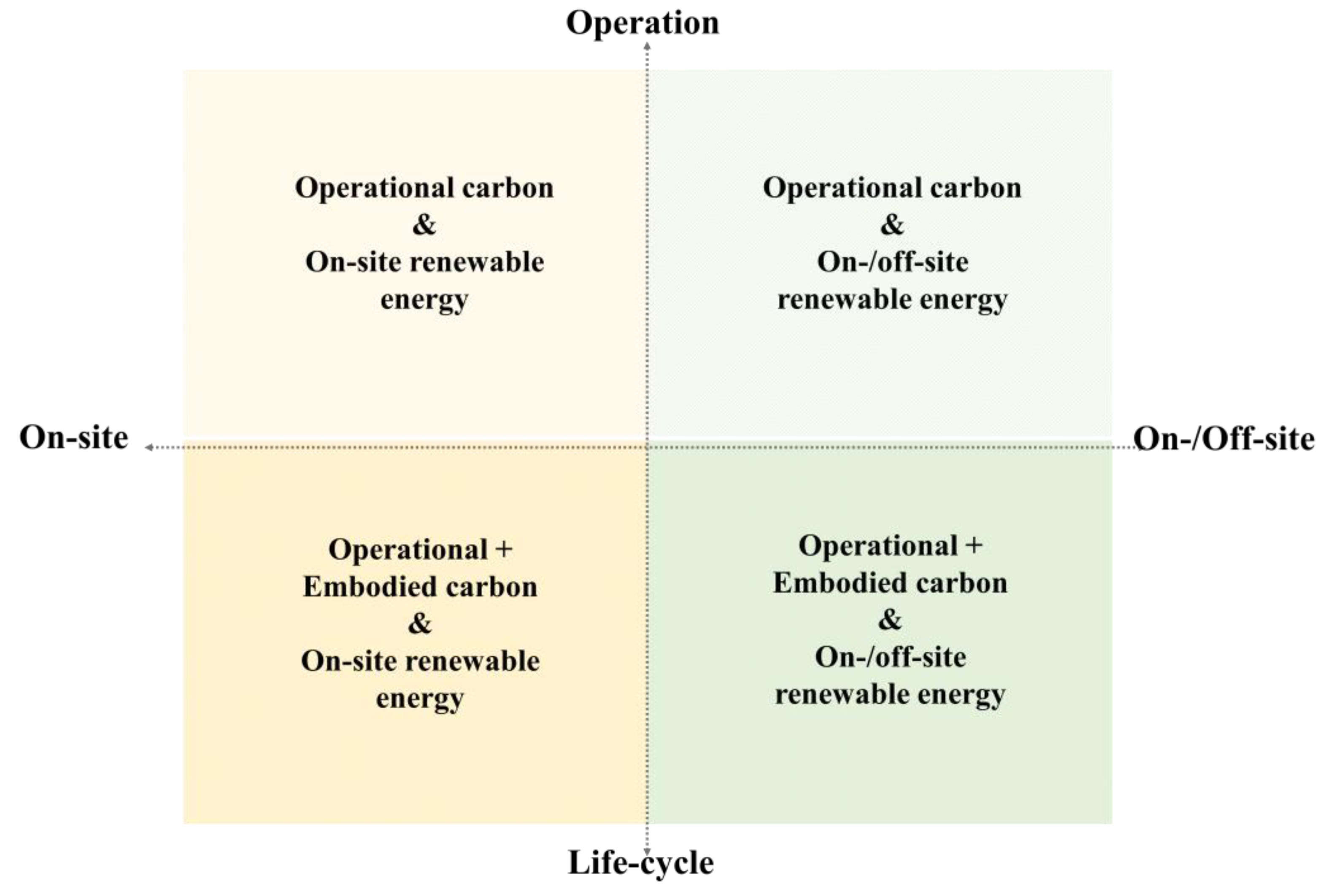
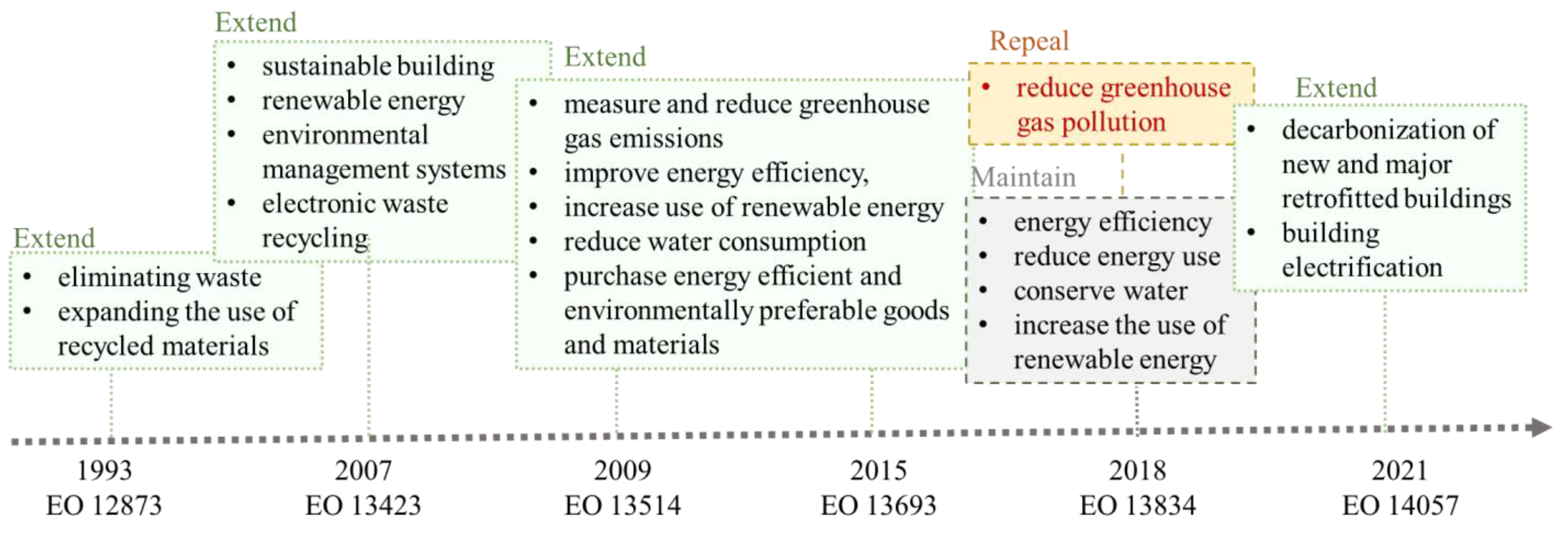

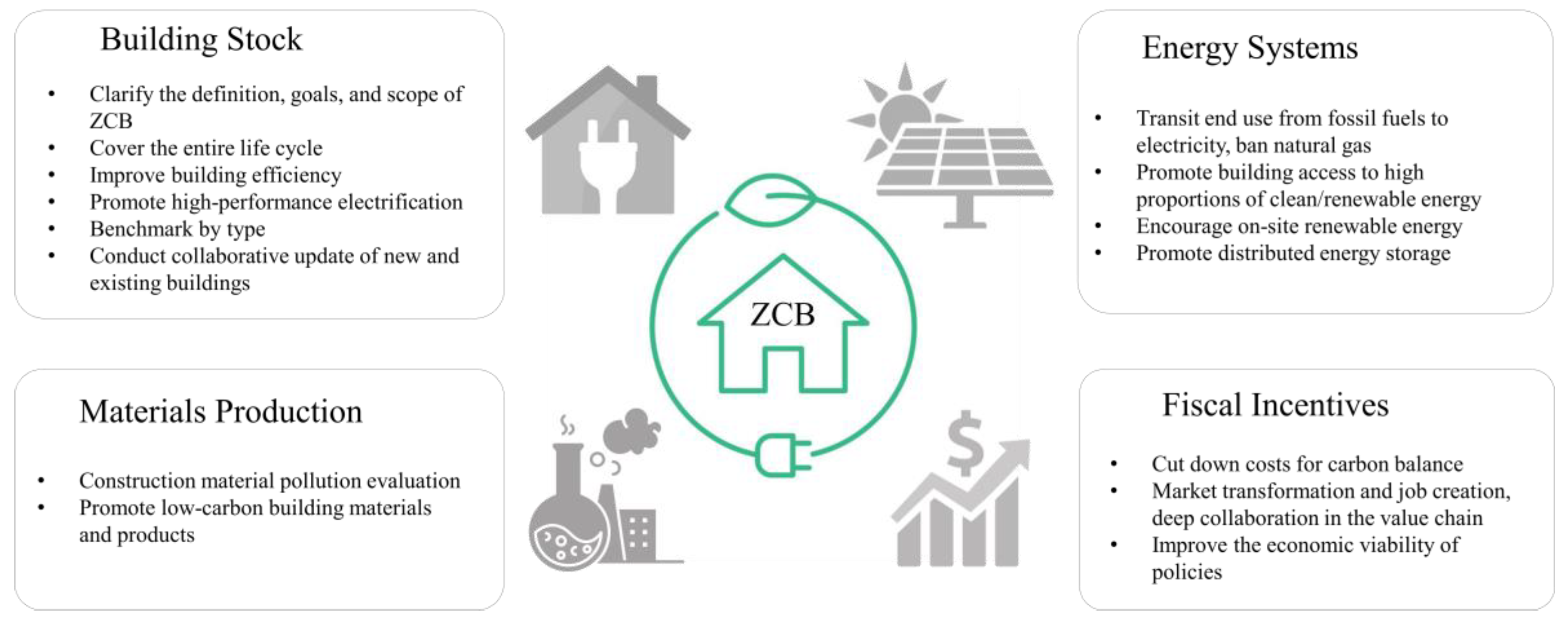
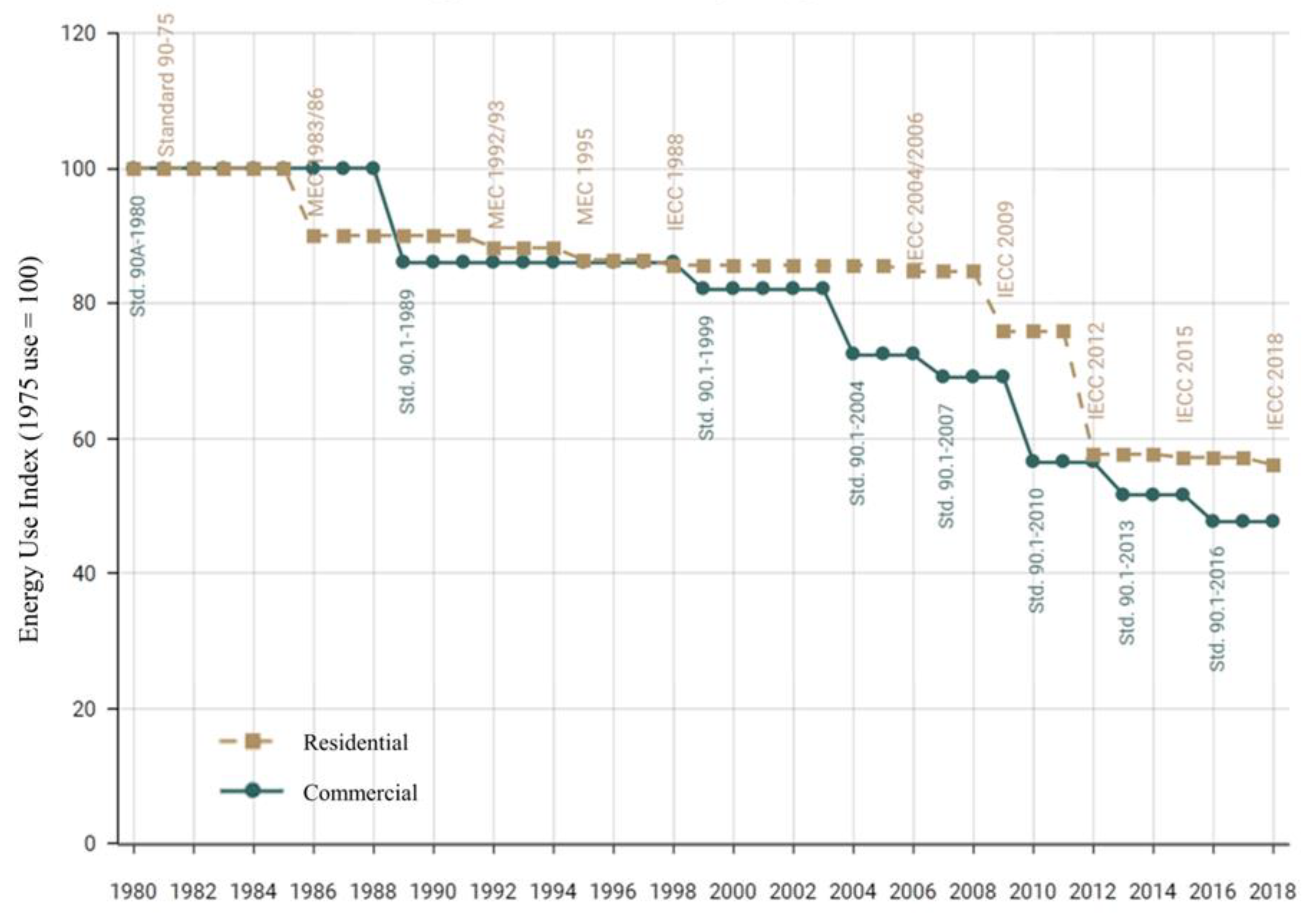
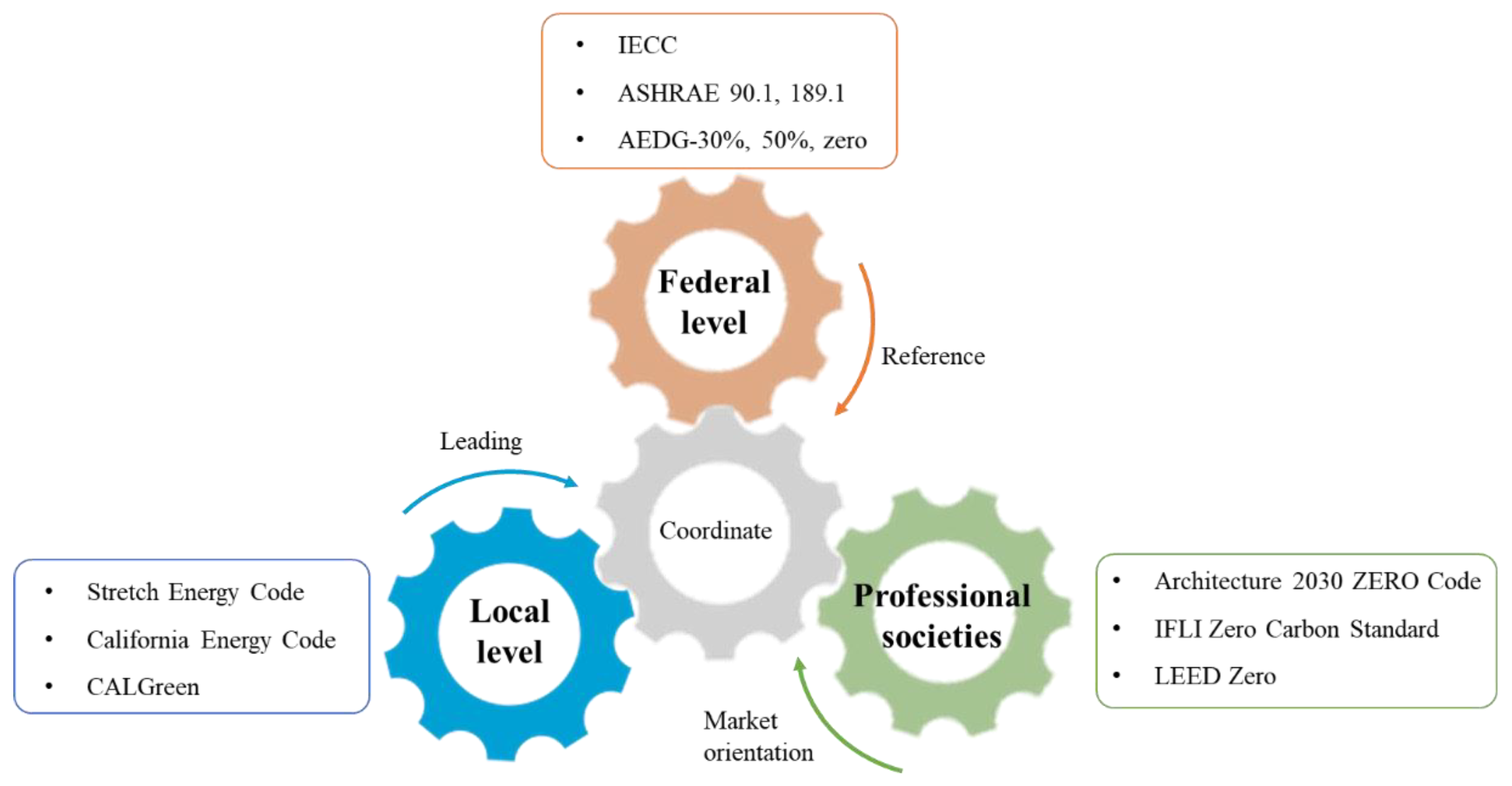
| Electricity Goals | Target Year | State (Year Passed) |
|---|---|---|
| Carbon-free | 2045 | California (2018), New Mexico (2019), Washington (2019), Maryland (2022) |
| 2050 | Colorado (2019), Nevada (2019), Wisconsin (2019), Virginia (2020), Louisiana (2020), Michigan (2020), New Jersey (2020), Illinois (2021), Massachusetts (2021), North Carolina (2021), Rhode Island (2021), Nebraska (2021) | |
| 2040 | New York (2019), Oregon (2021) | |
| 100% Renewable | 2045 | Hawaii (2015) |
| 2050 | Puerto Rico (2019) | |
| 2032 | Washington, D.C. (2019) |
| IECC [55] | ASHRAE 90.1 [56] | |
|---|---|---|
| Update frequency | 3 years | 3 years |
| Latest update | 2021 version | 2019 version |
| Update | 35 requirements | 88 supplementary |
| Content | High-efficiency lighting, external wall insulation, roof insulation, U-value of doors and windows, mechanical ventilation fans, heat recovery ventilation, natural lighting efficiency | Design and construction of building envelope, HVAC, hot water, lighting, other equipment |
| Improvement | 9.38% terminal energy saving | 4.7% terminal energy saving |
| 8.66% CO2 reduction | 4.2% CO2 reduction | |
| Base version | 2018 version | 2016 version |
| Stretch Energy Code [69] | NYStretch Energy Code [71] | “Reach” Code [72] | |
|---|---|---|---|
| Year(s) | 2008 | 2020 | 2016, 2019 |
| Jurisdiction | Massachusetts State | New York State | Santa Monica city |
| Improvement | / | 10% efficacy | 15% less energy |
| Base standard | 2008 Massachusetts Building Code | 2020 New York Energy Code | 2016 California Energy Code |
| Criteria | Cities/States |
|---|---|
| Annual greenhouse gas emissions | Boston, MA; New York, NY |
| ENERGY STAR Score | Chula Vista, CA; Washington, D.C. |
| Weather-normalized on-site EUI | Chula Vista, CA; Denver, CO; Washington State |
| On-site EUI | St. Louis, MO |
Publisher’s Note: MDPI stays neutral with regard to jurisdictional claims in published maps and institutional affiliations. |
© 2022 by the authors. Licensee MDPI, Basel, Switzerland. This article is an open access article distributed under the terms and conditions of the Creative Commons Attribution (CC BY) license (https://creativecommons.org/licenses/by/4.0/).
Share and Cite
Yu, F.; Feng, W.; Leng, J.; Wang, Y.; Bai, Y. Review of the U.S. Policies, Codes, and Standards of Zero-Carbon Buildings. Buildings 2022, 12, 2060. https://doi.org/10.3390/buildings12122060
Yu F, Feng W, Leng J, Wang Y, Bai Y. Review of the U.S. Policies, Codes, and Standards of Zero-Carbon Buildings. Buildings. 2022; 12(12):2060. https://doi.org/10.3390/buildings12122060
Chicago/Turabian StyleYu, Fei, Wei Feng, Jiawei Leng, Yibo Wang, and Yang Bai. 2022. "Review of the U.S. Policies, Codes, and Standards of Zero-Carbon Buildings" Buildings 12, no. 12: 2060. https://doi.org/10.3390/buildings12122060
APA StyleYu, F., Feng, W., Leng, J., Wang, Y., & Bai, Y. (2022). Review of the U.S. Policies, Codes, and Standards of Zero-Carbon Buildings. Buildings, 12(12), 2060. https://doi.org/10.3390/buildings12122060








